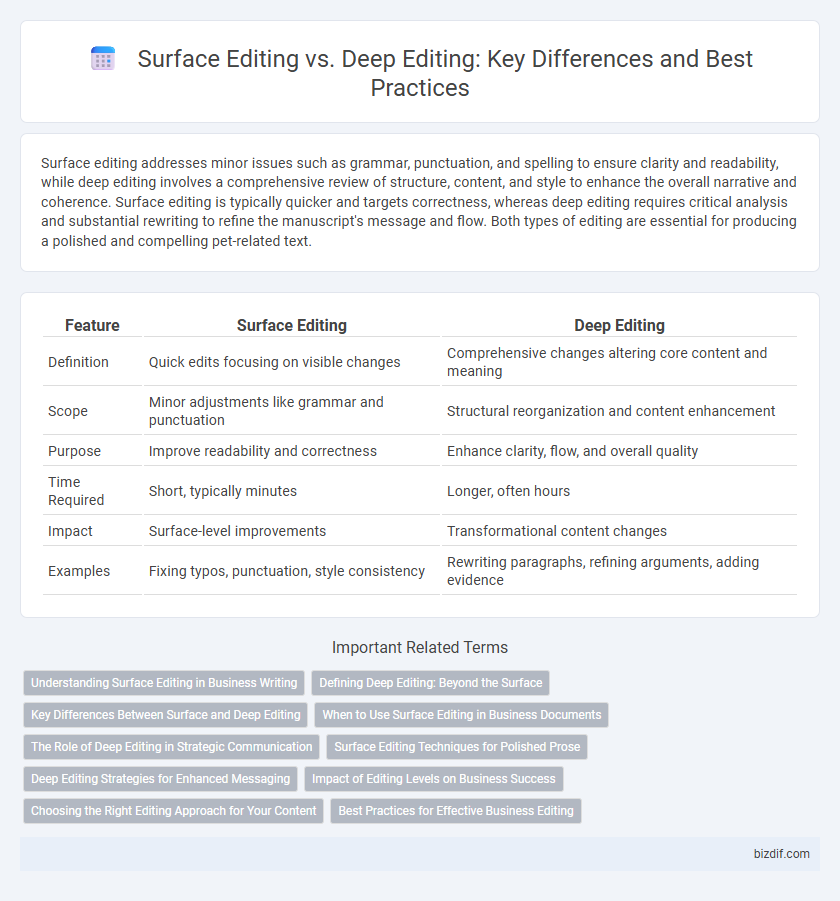Surface editing addresses minor issues such as grammar, punctuation, and spelling to ensure clarity and readability, while deep editing involves a comprehensive review of structure, content, and style to enhance the overall narrative and coherence. Surface editing is typically quicker and targets correctness, whereas deep editing requires critical analysis and substantial rewriting to refine the manuscript's message and flow. Both types of editing are essential for producing a polished and compelling pet-related text.
Table of Comparison
| Feature | Surface Editing | Deep Editing |
|---|---|---|
| Definition | Quick edits focusing on visible changes | Comprehensive changes altering core content and meaning |
| Scope | Minor adjustments like grammar and punctuation | Structural reorganization and content enhancement |
| Purpose | Improve readability and correctness | Enhance clarity, flow, and overall quality |
| Time Required | Short, typically minutes | Longer, often hours |
| Impact | Surface-level improvements | Transformational content changes |
| Examples | Fixing typos, punctuation, style consistency | Rewriting paragraphs, refining arguments, adding evidence |
Understanding Surface Editing in Business Writing
Surface editing in business writing involves correcting grammar, punctuation, spelling, and formatting errors to ensure clarity and professionalism. It focuses on improving readability without altering the original message or structure of the text. Mastery of surface editing enhances the overall presentation and effectiveness of business documents by eliminating distracting mistakes.
Defining Deep Editing: Beyond the Surface
Deep editing delves into the core of a manuscript by restructuring plot, refining character development, and enhancing thematic depth to create a more compelling narrative. It addresses inconsistencies, strengthens pacing, and sharpens the writer's voice, ensuring the story resonates emotionally and intellectually. Unlike surface editing, which corrects grammar and punctuation, deep editing transforms the overall substance and impact of the text.
Key Differences Between Surface and Deep Editing
Surface editing targets cosmetic issues like grammar, punctuation, and spelling to improve clarity and readability. Deep editing involves restructuring content, enhancing voice, tone, and overall message coherence to elevate the text's impact. Key differences lie in surface editing's focus on technical accuracy versus deep editing's emphasis on substantial content refinement and narrative flow.
When to Use Surface Editing in Business Documents
Surface editing is ideal for business documents requiring quick refinement of grammar, punctuation, and formatting errors to ensure professionalism and clarity. It is most effective when the content is already well-structured and the main message is clear, allowing for efficient polishing without altering the core ideas. Use surface editing for emails, reports, and presentations where time constraints demand swift, error-free communication.
The Role of Deep Editing in Strategic Communication
Deep editing enhances strategic communication by refining core messages to align with audience needs and organizational goals, ensuring clarity and impact beyond surface-level corrections. It involves restructuring content, improving tone, and emphasizing key points to strengthen persuasive power and coherence. This process is essential for crafting compelling narratives that drive engagement and achieve communication objectives.
Surface Editing Techniques for Polished Prose
Surface editing techniques refine grammar, punctuation, and spelling to ensure polished and error-free prose. This process involves careful line-by-line review to enhance clarity, consistency, and readability without altering the core content. Employing tools like style guides and proofreading software streamlines the detection of surface-level mistakes for a professional finish.
Deep Editing Strategies for Enhanced Messaging
Deep editing strategies enhance messaging by focusing on clarity, tone, and narrative structure, shaping the content to resonate deeply with the target audience. Techniques such as restructuring sentences for logical flow, refining voice to maintain consistency, and eliminating redundancies improve overall impact beyond surface-level grammar corrections. Employing these methods ensures the message is compelling, coherent, and aligned with the intended purpose.
Impact of Editing Levels on Business Success
Surface editing enhances clarity and professionalism by correcting grammar, spelling, and punctuation, which improves brand credibility and customer trust. Deep editing transforms content structure, tone, and messaging, directly influencing audience engagement and conversion rates. Businesses leveraging deep editing achieve higher market impact and long-term growth compared to those relying solely on surface editing.
Choosing the Right Editing Approach for Your Content
Choosing the right editing approach depends on the content's purpose and complexity; surface editing focuses on grammar, spelling, and punctuation to ensure readability, while deep editing addresses structure, clarity, and overall message coherence. For academic papers or professional reports, deep editing enhances argument strength and logical flow, whereas surface editing suits short articles or blog posts with minimal content restructuring needs. Evaluating the content type and intended audience guides editors in selecting between surface editing and deep editing to maximize communication impact.
Best Practices for Effective Business Editing
Surface editing targets grammar, punctuation, and spelling to ensure clarity and professionalism in business documents, while deep editing involves restructuring content, enhancing tone, and refining messaging for strategic impact. Best practices include combining both methods by first addressing surface-level errors to establish readability, followed by deep editing to align the text with organizational goals and audience expectations. Utilizing style guides and seeking feedback during the deep editing process further strengthens content quality and coherence in business communication.
Surface Editing vs Deep Editing Infographic

 bizdif.com
bizdif.com